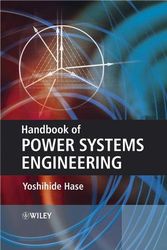Handbook of Power System Engineering
暫譯: 電力系統工程手冊
Yoshihide Hase
- 出版商: Wiley
- 售價: $5,760
- 貴賓價: 9.5 折 $5,472
- 語言: 英文
- 頁數: 574
- 裝訂: Paperback
- ISBN: 0470027428
- ISBN-13: 9780470027424
海外代購書籍(需單獨結帳)
相關主題
商品描述
Description
Maintaining the reliable and efficient generation, transmission and distribution of electrical power is of the utmost importance in a world where electricity is the inevitable means of energy acquisition, transportation, and utilization, and the principle mode of communicating media. Our modern society is entirely dependent on electricity, so problems involving the continuous delivery of power can lead to the disruption and breakdown of vital economic and social infrastructures.This book brings together comprehensive technical information on power system engineering, covering the fundamental theory of power systems and their components, and the related analytical approaches.
Key features:
- Presents detailed theoretical explanations of simple power systems as an accessible basis for understanding the larger, more complex power systems.
- Examines widely the theory, practices and implementation of several power sub-systems such as generating plants, over-head transmission lines and power cable lines, sub-stations, including over-voltage protection, insulation coordination as well as power systems control and protection.
- Discusses steady-state and transient phenomena from basic power-frequency range to lightning- and switching-surge ranges, including system faults, wave-form distortion and lower-order harmonic resonance.
- Explains the dynamics of generators and power systems through essential mathematical equations, with many numerical examples.
- Analyses the historical progression of power system engineering, in particular the descriptive methods of electrical circuits for power systems.
Written by an author with a wealth of experience in the field, both in industry and academia, the Handbook of Power System Engineering provides a single reference work for practicing engineers, researchers and those working in industry that want to gain knowledge of all aspects of power systems. It is also valuable for advanced students taking courses or modules in power system engineering.
Table of Contents
Preface.Acknowledgements.
About the Author.
Introduction.
Chapter 1: Overhead transmission line and their circuit constants.
Chapter 2 : Symmetrical coordinate method (Symmetrical components).
Chapter 3 : Fault analysis by symmetrical components.
Chapter 4 : Fault Analysis of Parallel circuit Lines (including Simultaneous Double Circuit Fault).
Chapter 5 :Per Unit method and introduction of transformer circuit.
Chapter 6 : α-β-0 Coordinate method(Clarke components) and it’s application.
Chapter 7 : Symmetrical and α-β-0 components as analytical tools of transient phenomena.
Chapter 8 : Neutral grounding methods.
Chapter 9: Visual vector diagrams of voltages and currents under faults condition.
Chapter 10 :Theory of generators.
Chapter 11 : Apparent power and it’s expression by 0-1-2 and d-q-0 domains.
Chapter12 : Generating power and steady-state stability.
Chapter13 : The Generator as Rotating Machinery.
Chapter 14 : Transient/Dynamic Stability, P-Q-V Characteristics and Voltage Stability of a Power System.
Chapter 15 : Generator characteristics with AVR and stable operation limit.
Chapter 16 : Operating characteristics and the capability limits of generators.
Chapter 17 : R-X Coordinates and the Theory of Directional Distance Relays.
Chapter 18 :Traveling-wave (surge) phenomena.
Chapter 19 : Switching surge phenomena by circuit-breakers and line-switches.
Chapter 20 : Overvoltage phenomena.
Chapter 21 : Insulation Coordination.
Chapter 22 : Waveform distortion and lower order harmonic resonance.
Chapter 23 : Power Cables. .
Chapter 24 : Approaches for special circuits.
Appendix A - Mathematical Formulae.
Appendix B - Matrix Equation Formulae.
Analytical Methods Index.
Components Index.
Subject Index.
商品描述(中文翻譯)
**描述**
維持電力的可靠和高效生成、傳輸及分配在一個電力是不可避免的能源獲取、運輸和利用手段,以及主要的傳播媒介的世界中至關重要。我們的現代社會完全依賴電力,因此涉及持續供電的問題可能導致重要經濟和社會基礎設施的中斷和崩潰。
本書匯集了有關電力系統工程的全面技術信息,涵蓋了電力系統及其組件的基本理論,以及相關的分析方法。
**主要特點:**
- 提供簡單電力系統的詳細理論解釋,作為理解更大、更複雜電力系統的可接近基礎。
- 廣泛檢視多個電力子系統的理論、實踐和實施,例如發電廠、架空傳輸線和電力電纜線、變電站,包括過電壓保護、絕緣協調以及電力系統的控制和保護。
- 討論從基本電力頻率範圍到雷電和開關浪湧範圍的穩態和暫態現象,包括系統故障、波形失真和低階諧波共振。
- 通過基本數學方程解釋發電機和電力系統的動態,並提供許多數值範例。
- 分析電力系統工程的歷史進程,特別是電力系統的電路描述方法。
本書由一位在行業和學術界擁有豐富經驗的作者撰寫,《電力系統工程手冊》為實踐工程師、研究人員及希望獲得電力系統各方面知識的行業工作者提供了一個單一的參考資料。對於修習電力系統工程課程或模組的高級學生也具有重要價值。
**目錄**
前言
致謝
關於作者
介紹
第1章:架空傳輸線及其電路常數
第2章:對稱座標法(對稱分量)
第3章:通過對稱分量進行故障分析
第4章:平行電路線的故障分析(包括同時雙電路故障)
第5章:每單位法及變壓器電路的介紹
第6章:α-β-0座標法(克拉克分量)及其應用
第7章:對稱分量和α-β-0分量作為暫態現象的分析工具
第8章:中性接地方法
第9章:故障條件下電壓和電流的視覺向量圖
第10章:發電機理論
第11章:視在功率及其在0-1-2和d-q-0域中的表達
第12章:發電功率和穩態穩定性
第13章:發電機作為旋轉機械
第14章:暫態/動態穩定性、P-Q-V特性及電力系統的電壓穩定性
第15章:帶有自動電壓調節器(AVR)的發電機特性及穩定運行極限
第16章:發電機的操作特性及能力極限
第17章:R-X座標及方向距離繼電器理論
第18章:行波(浪湧)現象
第19章:由斷路器和線路開關引起的開關浪湧現象
第20章:過電壓現象
第21章:絕緣協調
第22章:波形失真和低階諧波共振
第23章:電力電纜
第24章:特殊電路的方法
附錄A - 數學公式
附錄B - 矩陣方程公式
分析方法索引
組件索引
主題索引



















